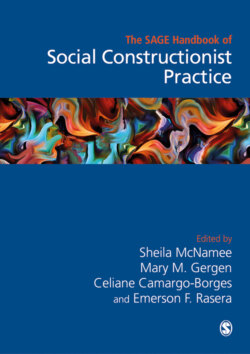Читать книгу The Sage Handbook of Social Constructionist Practice - Группа авторов - Страница 101
На сайте Литреса книга снята с продажи.
8 To Know and Not to Know: Dialogic Social Inquiry
ОглавлениеRocio Chaveste and M. L. Papusa Molina, with Christian Lizama, Cynthia Sosa, and Carolina Torres
… what the occasion calls for, and in the manner called for (Harlene Anderson)
The writing of this piece requires going back to a conversation between Papusa and Cynthia, one of the students involved in this process. Papusa was at the time, and still is, the Research Methodology professor in all the MA programs at the Kanankil Institute.1 She came from a feminist background in research, but she was teaching the class without paying attention to socio-constructionist and collaborative-dialogic practices. While teaching her class, Cynthia asked her, ‘Why do we have to do semi-structured interviews or another type of qualitative approach when writing our thesis? It feels awkward in the context of the institute.’
So, the conversation continued: ‘What do you suggest?’ ‘Well, do you know Janice DeFehr? She is writing her Ph.D. dissertation with Harlene as her academic Advisor. She is proposing a way to approach research from a social-dialogic perspective.’ ‘Is there something I could read about it?’ ‘Well – Cynthia answered – let me write to her and ask if she is willing to share with us her manuscript.’ Cynthia did ask, Janice did share, and a whole adventure started for us at Kanankil.
The related conversation happened in 2008. Eleven years later, we got together with Cynthia, Carolina, and Christian and talked for about an hour and a half about writing their MA thesis from a perspective that we have started to call Dialogic Social Inquiry (from now on referred to as DSI). The three of them had graduated from Kanankil, and nowadays are professors at the Institute. The topics of their theses are entirely different: Cynthia (2013) on women's leadership, Carolina (2016) on families living with a disabled child, and Christian (2013) on couples’ infidelity.
The intention is to share with the reader the experience they had when facilitating their inquiry process, and how do we do ‘relational research’. We are writing it in quotation marks because, in a certain way, we consider that all research is relational. As you may be aware, the introduction to this section already explains relational research as understood by social constructionist practitioners. However, the type of relational research we would like to address in this chapter lies in the type of relations and dialogues we establish among all the people who participate in the inquiry process, including the potential readers, as well as some of the methodological implications. We will share how we conceptualize DSI anchored in a dialogic process – described by Jaakko Seikkula (2003), among others, as ‘one in which answers are more important than questions. Yet this new utterance, with its answers, is not an end of the conversation, but a new question aimed at promoting the theme under discussion. It is the theme itself – not the individuals participating in the conversation – that guides the dialogue’ (p. 89). Vicente Sisto (2008) refers to this shift as
the change concerning the relationship with the other in the process of producing research. From being a process of gathering data placed on a subject, considered as an object, it is now considered a process of dialogic production between two subjects positioned differently. What is produced emerges, therefore, from this relation. (p. 114)
So, the five of us sat around a table with a recorder at hand three months ago, and a conversation started with one simple question: ‘how was the experience of writing your thesis from a Dialogic Social Inquiry approach?’ Cynthia, who started this process at Kanankil, led the way, saying: ‘it was like creating and constructing … it was very rich, very free’. ‘Very organic’, Carolina followed and continued:
It was transformative in several ways, and reflected in some of my diverse identities: as a researcher, it meant moving from a quantitative paradigm to this one; as a mother, it helps me expand my stories of and how I assume my motherhood; as a therapist, I started to have more points of view from which to look upon these stories; as director of a special education center, it allowed me to get closer and more involved with the families in decision-making processes; etc.
Christian took some time to respond and let the conversation flow. After a while, he said: ‘I lived it very differently.’ He went ahead and described how, while he was writing his thesis, he was in parallel writing a novel. His description of the process was about dialogues that got generated between the two pieces: ‘the dialogues had a life of their own … I realized that one made the other more creative’. Rocio reflected: ‘… a process that generated other processes’.
